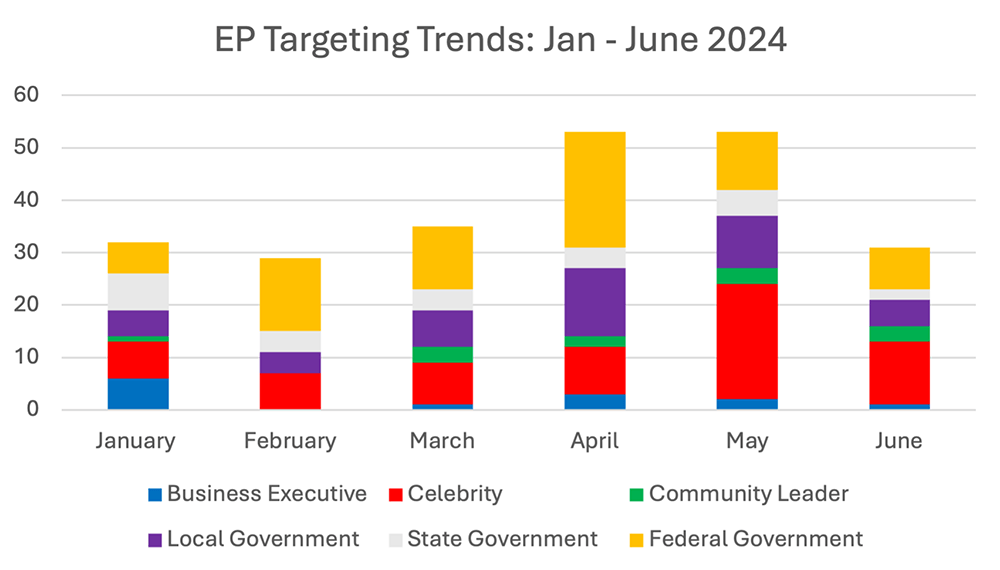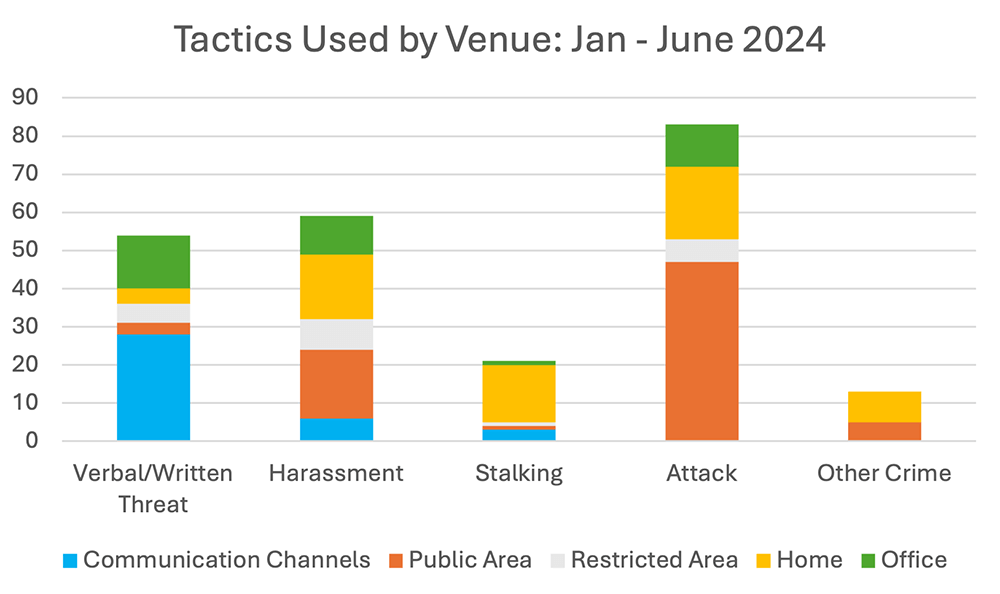
Executive Protection Trends: First Half of 2024
TorchStone has documented 231 incidents targeting high-profile individuals around the world over the first six months of 2024. Threats so far this year have been defined by national elections, protest over the Israel-Palestine conflict, and evolving climate change protest tactics. Election-related incidents are set to continue with the U.S. electoral cycle ramping up, as demonstrated by the July 13 assassination attempt against Donald Trump.
Tactics during the first half of 2024 shifted from verbal and written threats to attacks, suggesting a trend towards more threatening incidents targeting high-profile individuals.
Finally, public areas were the most common venue for incidents, followed closely by the home. This trend highlights the importance of focusing resources on principals’ homes, as it is the most predictable place where assailants can find their targets.
Targets
Government leaders remained the most targeted group, with federal-level officials making up half of all incidents targeting governments. Violent threats and attacks targeted elections in India, Mexico, the United Kingdom, France, and elsewhere, contributing to incidents targeting government leaders at all levels. Mexico especially experienced an increase in attacks on political figures in the lead-up to its election on June 2. Celebrities remained the second most targeted group after federal government officials: a rash of burglaries targeting current and former NBA basketball players’ homes in the Los Angeles area in May and June contributed to attacks on celebrities.
Election-related violence in France, the UK, India, and especially Mexico suggests that hostile incidents targeting U.S. government officials could increase during the upcoming election cycle. The assassination attempt against Republican Presidential candidate Donald Trump on July 13 highlights the severity of the threat. The January 6, 2021, attack on the U.S. Capitol is another example from the most recent Presidential election cycle of how government leaders can come under increasing threat during and after the election season. Incidents in other countries demonstrate that lower-profile politicians (especially local government officials) are more likely to be targeted by angry constituents, activist groups, and violent individuals. The July 13 assassination attempt and January 6 attack also demonstrated the peripheral threat to crowds and law enforcement: no targeted government leaders were killed in either attack, but participants and law enforcement did succumb to injuries and death.
The combination of pro-Palestine and climate change protests in the spring led to a wave of incidents targeting federal government officials. However, local government officials, celebrities, and business executives were also targets of the protest campaigns. There has been a summer lull in incidents linked to the pro-Palestine movement as student-led protests fizzle. Still, the return to campus this fall could see a resumption of protest activity and incidents targeting high-profile individuals. Pro-Palestine-linked incidents peaked in April (12) but declined in May (5) and June (1).
Meanwhile, climate change groups have continued to promote their cause through disruptive actions targeting business executives, celebrities, and government leaders. Unlike the Palestine protest movement, the climate change protest campaign is a much more sustained movement that is likely to persist for years to come. There are ample opportunities for activists to target specific individuals—especially business executives associated with carbon-emitting industries such as oil & gas, transportation, and manufacturing. This also includes companies that finance or otherwise do business with the energy sector. TorchStone anticipates this to be a persistent threat for corporate security teams for the foreseeable future.
Tactics
In the first half of 2024, TorchStone introduced “Other Crime” as a new tactics category. This covers mostly financially motivated criminal activity, such as burglary, robbery, and muggings.
Physical attack was the most common tactic used against principals over the past six months, followed by harassment and verbal/written threats. It is concerning that attacks have overtaken verbal and written threats as the most commonly used tactic.
Celebrities suffered the most attacks of any other target sets, accounting for 36% of all attacks on high-profile individuals over the past six months. A rivalry between rappers Drake and Kendrick Lamar led to verbal and physical retaliations: in May, a security guard posted outside Drake’s Toronto residence was shot and injured when a passing vehicle opened fire.
Venues
In the first half of 2024, TorchStone introduced “Communication Channels” as a new venue for incidents. A majority of verbal/written threats occur over the phone, through email, social media, or written letters, which justify a category separate from home and office. Stalking and harassment can also occur through communication channels. Communication channels are more accessible to the public than a principal’s home or office and so, in general, pose a less imminent threat than incidents targeting physical locations associated with a principal.
As highlighted in our recent article, Threat Comes Homethe home is one of the most common venues for incidents targeting all types of high-profile individuals. During the first 6 months of 2024, 27% of all incidents occurred at the victim’s home, second only to incidents in public areas (32%). While security teams are limited in their options for securing principals in public areas, they have much more control over residential security: establishing good residential security measures and ensuring electronic home security systems are in good working order—and as importantly, are used—are very attainable security measures to reduce the threat at principals’ homes.
Conclusion
As the U.S. election approaches, government officials are likely to be the target of threats, harassment, and physical attacks. Based on previous years, the elevated threat has the potential to persist beyond November 5.
The return of classes in August and September could also bring a resumption of nationwide campus pro-Palestine protests and an increase in related threats and harassment targeting high-profile individuals.
Ultimately, most incidents targeting high-profile individuals are related to specific, localized grievances or opportunistic crimes. However, by identifying threats early, assessing them, and monitoring them for changes, security teams can mitigate the threats to their principals.




